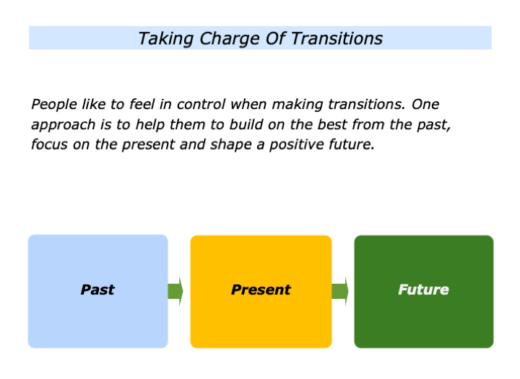
People like to feel in control, especially when faced by the possibility of change. They want to have some influence on shaping their future lives.
This article describes how people can be helped to make transitions when part of a team. They can follow similar principles, however, to make transitions in other areas of their lives.
People sometimes want to cling to the past. Whilst it is good for them to respect the heritage they have built, they may also need to embrace the future.
Imagine that you lead a team that has to make changes in order to stay ahead of the game. Let’s explore how to make this happen.
Setting The Scene
Gather people together and explain that you want to focus on how the team can continue to develop. One leader explained this in the following way.
The purpose of this session is to look at how we can continue to shape a successful future.
Looking back, we have done outstanding work when acting as trusted advisors to clients. We have also worked well together when tackling certain crises.
Looking ahead, we must continue to do what we do best. We also need to keep our internal stakeholders happy. The profit targets are mandatory, so we need to find ways to hit these targets.
We also need to be proactive in keeping our stakeholders informed about our progress towards achieving the goals. This will stop them worrying.
Many of our competitors are producing new applications that could put us out of business. We need to build on our strengths and develop ways to help our customers to achieve success.
As you know, several team members are in the process of moving on to other jobs, so we have some openings in the team. One option is to hire more technical specialists.
The other option is to hire more people who can act as co-ordinators. They will run the projects and free you up to do what you do best.
We are moving to a new office. This gives us an opportunity to reconfigure the way we work. At the same time, however, it will be important to keep the good things we like about working together.
My role as a leader is to create a culture in which motivated people can do fine work. Your role is to choose to opt in, encourage other people and help the team to achieve its goals.
Bearing these things in mind, I am going to invite you to share how we can continue to do superb work in the future.
There are many ways to set the scene when inviting people to take charge of a transition. People often work best, however, when they are able to see the big picture.
Building On The
Best From The Past
Imagine that you have set the context in your own way. You can then invite people to do the following exercise. Give each person a pile of Post-it Notes. They are to each write ideas on the following themes.
The specific things we can take forward from the past are …
The specific steps we can take to do these things in the future are …
The specific benefits of doing these things will be …
Give people 15 minutes to write their ideas. They are then to each go up in turn and put their ideas on flip charts.
People come up with interesting and sometimes unexpected ideas when doing this exercise. Those in one team wrote, for example:
The specific things we can
take forward from the past are:
The chance to have coffee with the leader … The chance to input into how we achieve the team’s goals … The ethic of giving great customer service … The charity work we do mentoring young people in schools … The chance to work remotely providing we deliver the required results … The profit share.
If appropriate, you can have a discussion after people have put their Post-it Notes on the flip charts. Alternatively, you can leave the discussion until people have also done the next exercise.
Developing In The Future
You can then invite people to look into the future. If you wish, you can set the context by asking some of the following questions.
How can we continue to build on our strengths? How can we compensate for any weaknesses? How can we continue to perform superb work?
How can we be even better trusted advisors? How can we help customers to reach their goals? How can we generate and publish success stories?
How can we anticipate future challenges in the market? How can we prepare properly to deal with these challenges? How can we ensure our offering will provide better results than that provided by other suppliers?
How can we keep building good relationships with our internal stakeholders? How can we proactively inform stakeholders about our progress towards the agreed goals? How can we do this in an appropriate way that keeps the stakeholders happy?
How can we implement effective processes in the team? How can we be clear on what we want to: a) keep doing; b) start doing; c) stop doing? How can we take ownership for making sure these ideas are implemented?
How can we maintain the morale in the team? How can we ensure that people are playing to their strengths? How can we ensure that all the other practical tasks are getting done?
How can we continue to contribute to the wider community? How can we share our knowledge with young people, schools and other places? How can we speak at conferences and continue to build a good reputation?
Give people 15 minutes to write their ideas on Post-it Notes. They can then each go up in turn and put their ideas on the following flip charts.
If appropriate, have a discussion about the ideas people have put on the flip charts. It will then be time to move on to the next stage.
Taking Charge
Of The Transition
Good leaders explain the reality of a situation, especially if a team needs to step up its game. They give the big picture and explain the strategic options for going forward.
Such leaders recognise it is vital to have a team of people who want to opt in and shape the future. So they may say something like the following
The world is changing. Maybe we would prefer that things stayed the same, but we now live in a different world.
The team can succeed in this new environment, but we will need to manage the transition. This will call for believing in the agreed way forward and working together to make it happen.
Looking ahead, each of us has several options when facing the need to develop in a changing world. We can choose:
a) To carry on as before.
b) To try to fight the changes.
c) To say we will implement the changes, but only go through the motions.
d) To continue to build on our strengths, develop and manage the changes successfully.
e) To leave for other places.
Each option does, of course, have consequences. My choice is to go for Option (d).
Let me know if you want to continue to contribute towards helping the team shape a successful future.
Good leaders prepare people for making such decisions by doing the exercises mentioned earlier. People are then more likely to feel in charge of shaping their futures.
This article has focused on helping people in a team to go through these steps. As mentioned earlier, however, individuals can follow similar principles in their own lives.
Looking ahead at the transitions they may need to make, an individual can focus on the following things.
The specific things I want to take forward from the past are …
The specific things I want to add, develop or do differently in the future are …
The specific things I can do to take charge of the transition are …
Let’s return to your team. You have invited people to describe how to build on the best from the past and develop in the future.
Many ideas will have been generated. Bearing these in mind, agree on the ones to be implemented. Get owners who will make these things happen.
Conclude the session by inviting these owners to do the exercise described at the end of this article. They are to make action plans and build in some early successes.
People can meet in one month’s time to describe: a) the specific things they have delivered in the past month; b) the specific things they plan to deliver in the next month.
Continue to meet with the team each month to share successes and tackle new challenges. Encourage them to build on the best from the past and also take charge of making the transition.
Here is the final exercise you can invite the owners to do when making actions plans. You can then encourage and enable people to deliver success.


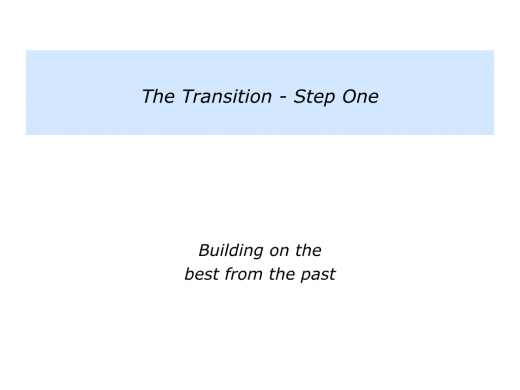
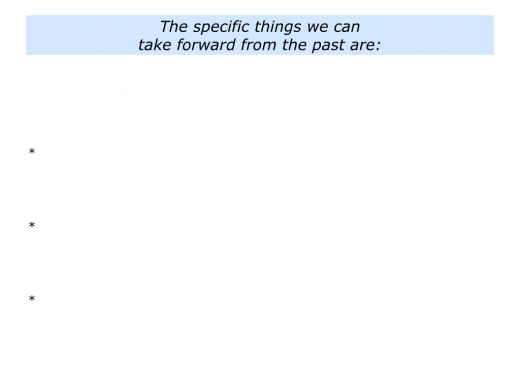
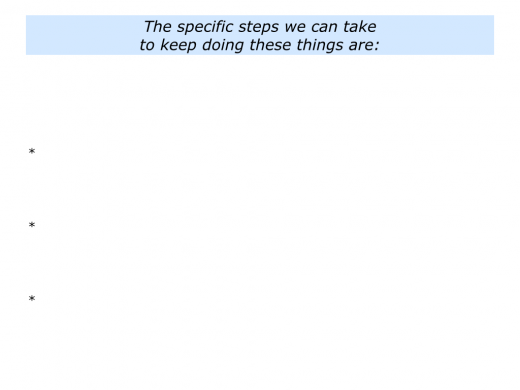
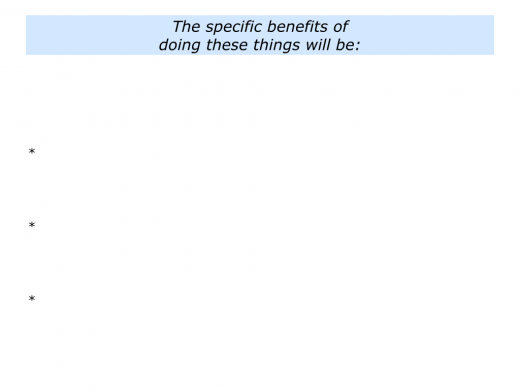
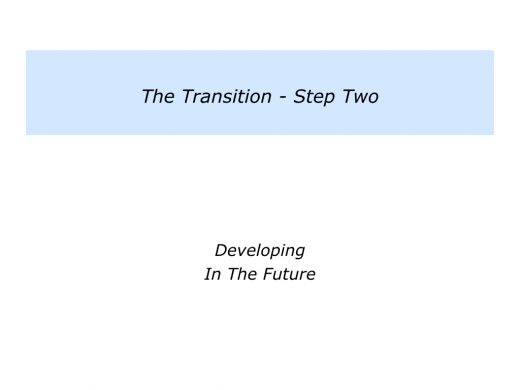
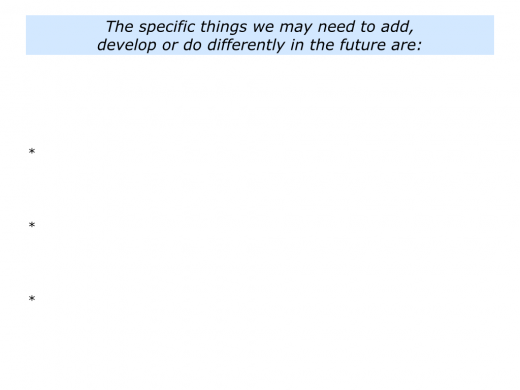
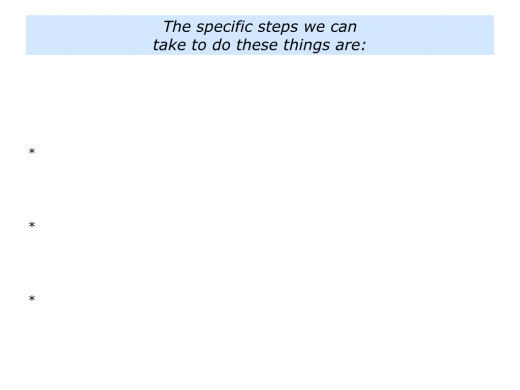
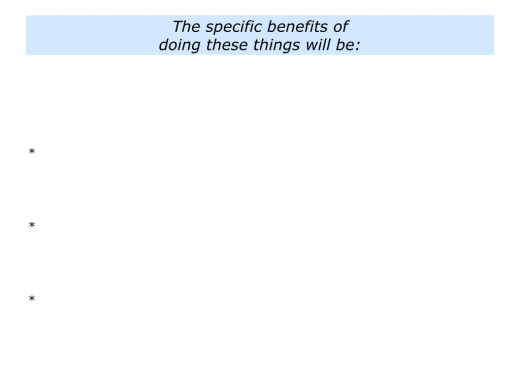

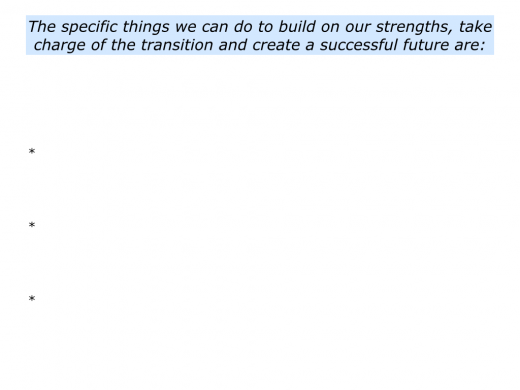
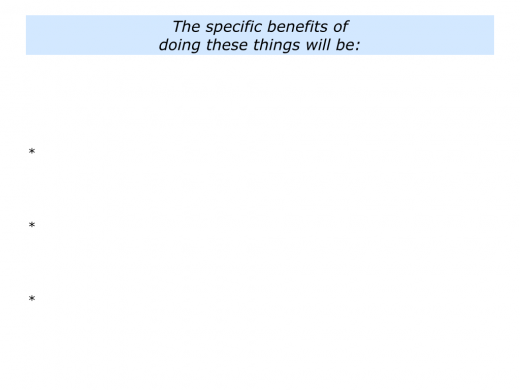




Leave a Reply